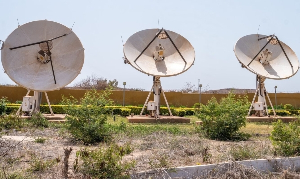...VRA Harps On Energy Conservation
THE VOLTA RIVER AUTHORITY (VRA) is undertaking a retrofitting project on one of its six unit generators at Akosombo at a cost of ?123,850,881.
The retrofitting exercise that began on the 19th of last month will be completed in August of this year, a nine month project.
The aim is to save the dam built in 1965 at ?70million from collapse.
All the six unit generators delivering 912 megawatts capacity are not adequate to meet the nation's energy demand.
To save the situation, the Volta River Authority has advised the public to minimise the use of high current drawing equipment between the peak period of 6pm and 10pm.
If this advice would be taken religiously, about 200 megawatts of power could be saved to lessen the burden on the plant.
The Akosombo Plant Manager, Mr. Kirk Koffi, hinted that the rainfall for last year at the catchment areas into the lake has been very disappointing, and to curtail blackouts, the VRA needs 10million dollars every three weeks to import light crude oil for the Aboadze thermal plant to supplement the generation from Akosombo.
Formerly the same amount was used for four weeks. Presently, VRA imports 7 cents per unit of electricity from the Ivory Coast.
In the past, Akosombo alone could supply 30% of power for domestic use and 70% for non-domestic purposes but it is now the opposite where domestic demand is rather higher.
The problem with the current situation, however, is that the domestic consumer cannot pay, hence the authority has an outstanding debt of $50million that it owes the Ivory Coast.
On the supply of power to Togo and Benin, the plant manager said that 30 and 50 megawatts respective contractual agreements were entered into and some of hard earned currency paid is used to purchase needed spare parts.
Mr. Kirk Koffi wants Ghanaians to brace themselves to pay high tariff to sustain the Volta dam and power supply in general in Ghana.
At worst, he said, the 30 megawatt diesel plant at Tema will have to be run for a few industries in Tema, especially for Ghacem but this also he said is very expensive.
Asked if the construction of another dam will not be viable looking at the blank state of power generation through diesel and thermal plants, the manager said that that will even cost more, stating that after the Volta Lake was created, 80,000 people affected were resettled at 52 resettlement villages whose main occupations included farming, poultry, piggery and fishing.
The idea of pumping water back into the reservoir he said must be discarded because you need to run fuel-powered generators and motors to achieve this and apart from the cost which is unbearable, the downstream dam at Kpong will also be affected.
After carefully considering this, the VRA has taken the bold step to retrofit the existing six unit generators which life span of 30 years has exceeded and are in grace period.
The project when completed will improve the performance, reliability, maintenance and operations of the units.
Potentials for improvement identified were replacement of the runner with a more efficient one, modification of the stay vanes, wicket gates draft tube, rewinding of generator stator to improve upon its generating capacity and upgrading unit transformers to deliver extra power from the turbines.
According to him, efficiency test performed on units that has been retrofitted establishes the guaranteed efficiency of 93.5%.
Financial support for the retrofitting project came from the International Development Association (IDA), $7,682,827; European Investment Bank $47,168,059; VRA $61,912,112 in addition to local currency (?42,236,642,630) $7,087,888.
Major industrial nations such as the United States of America, Canada and Japan are all retrofitting because apart from renewing the units, some manufacturers of these equipment are no more existing making it difficult to obtain spare parts.
Kirk Koffi said 1982, 1983, 1984, 1997, 1998 and 2001 are worse periods for intake for the water level.
In December of 1999, the level was two feet below that of 2000 Since the transformers were installed in 1965, the incident that occurred last week was the third.
According to him, the first one happened in 1979, second two years ago, and last year.
He stated that on Monday December 10, last year at about 1811hrs GMT one phase of the transformer number one went off and he quickly rallied his team of engineers and technicians to work.
Luckily , a spare 180MVA transformer costing between $1million and 1.2million on a standby for 21 years was used to replace the faulty one.
At the time of the visit, the new transformer was replaced, connected and undergoing test running.
Later investigations will be conducted to ascertain why one phase went off.











